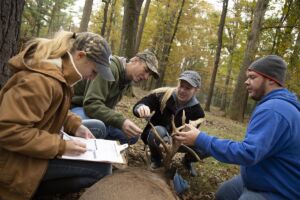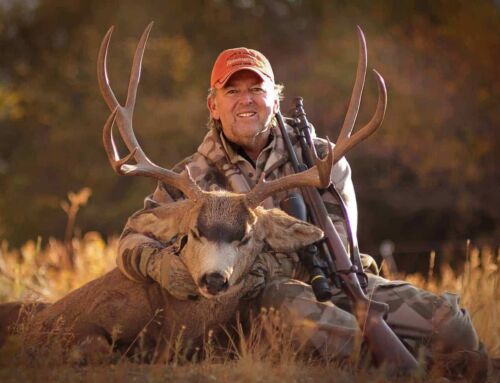 When deer scientists talk, I listen. Men and women who make a career of studying the whitetail don’t do it for fame or money. Having grinded for years to obtain a master’s degree in wildlife ecology, and in many cases a PhD to boot, they are passionate about learning all they can about America’s most popular game animal, and then implementing best practices for managing herds across the nation.
When deer scientists talk, I listen. Men and women who make a career of studying the whitetail don’t do it for fame or money. Having grinded for years to obtain a master’s degree in wildlife ecology, and in many cases a PhD to boot, they are passionate about learning all they can about America’s most popular game animal, and then implementing best practices for managing herds across the nation.
When the biologists are also hunters, as most mentioned here are, I double down on their data because I’m confident it will help me, and you, shoot more big deer.
Rubs: Zero to 100s
In a Michigan study, whitetails were totally removed from an enclosure; no deer inhabited the place for 3 years. In the fall of year four, deer were restocked into the pen. Some of the does and bucks were from Michigan, and others were trucked in from other states.
Get this: Bucks in the newly replanted herd immediately began blazing and using the same rubs as their predecessors made years ago! Fascinating, and science to use to your advantage.
As you scout, pinpoint clusters of brown, scarred trees that bucks blazed in previous years, and hang tree stands in thick cover nearby. “New” bucks will hit and use many of those old rubs later this fall.
Deer Cover
“Everybody needs a safe, comfortable place to sleep, even deer, says Pennsylvania biologist Jeannine Fleegle.
Her research shows that the best security cover is vegetation thick enough to hide 90% of a deer from observation at a distance of 200 feet or less. “That’s pretty thick,” she notes. “Saplings and shrubs do the job very well.”
Is that thicket 50 yards ahead dense enough to hide 90% of a bedded buck? Think like that as you scout, still-hunt or approach a stand.
Swamp Giants
Biologists worked a project in southern Delaware for 4 years, capturing and collaring bucks with GPS. They separated the deer into 2 age classes–4½ and younger and 5½ and older—and monitored their movements around swamps and marshes.
They found that the oldest bucks hardly ever left the swamps until cover of darkness. The younger bucks not only left the marsh on occasion, they also readily used nearby upland forests and crop fields. The 5-year-olds routinely avoided those areas.
The scientists wrote, “Not using wetland areas increased a buck’s risk of mortality by 2.7, meaning he was nearly 3 times more likely to be killed compared to a buck who regularly hid out in swamps.”
Further, the experts noted that bucks need to learn from experience before they begin to use any nearly impenetrable sanctuary. Once they do learn to use it, they become much harder to kill.
The big tip: Hunt the fringes and limit hunting pressure in and around a swamp or any sanctuary so you won’t educate mature bucks and make them un-killable.
Big Bucks Go Where You Won’t
Scientists tracked the movements of adult bucks fitted with GPS on a hunted property on the Maryland coast. Two sites in particular stood out as core areas for multiple bucks.
“One is nearly impenetrable to humans, very dense greenbrier and other thorny vegetation. The only way you can get into it is to find a deer trail and get on your hands and knees and go in there,” says Dr. Mark Conner, who headed up the project.
The other is a 25-acre designated waterfowl sanctuary that surrounds a pond. Human activity is restricted to avoid disturbing the geese and ducks.
This spot is basically the opposite of the first core bedding area, a mix of open woodlands, fields and grasses. “But like the other sanctuary, there is no human disturbance,” says Dr. Conner.
Lesson is simple: Anywhere in America, old, big-racked deer spend most of their time where hunters can’t or won’t go. Hunt the downwind edges of a core bedding area and hope to get a crack at a good buck if and when he sticks his neck out.
Hunt Late on Public Land
In another study at Mississippi State, scientists tracked buck movements and found that in early to mid-December (and into mid-January in Southern areas with peak rut in December) you can often see good rutting action on a WMA or national forest where does far outnumber bucks.
The biologists said that on uncultivated land where the buck:doe ratio is out of whack, there aren’t enough bucks to breed most of the adult does during the peak November estrus cycle. Some 28 days later a good number of “missed” does cycle back into heat and draw multiple bucks out of the woodwork and concentrate them in certain areas.
If you grind it out on public and are in the right place at the right time in December or January, you might well spot a hot doe with a buck(s) on her heels. Even better, the MSU study found that bucks 2.5 years and older do most of the late breeding, so you might shoot a deer with a nice rack for public land.





